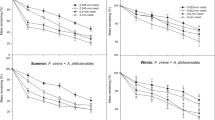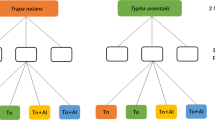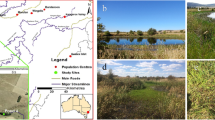Abstract
Potentilla anserina is a common invasive species of Patagonian wetlands. Although this species is commonly found in temporary habitats, where it establishes during the dry phase, the littoral zones of lakes are also susceptible, as water fluctuations make this habitat extremely variable in terms of water availability. Decay rates and nutrient release of P. anserina were compared with two native macrophyte species, Eleocharis pachycarpa and Schoenoplectus californicus, in two different freshwater environments: a temporary wetland, where P. anserina develops important stands, and the littoral zone of a lake not yet colonized by the invasive plant. Our results showed that both environments differed in nutrient concentrations, being higher in the temporary wetland. However, the invasive species decomposed faster in the littoral zone of the lake, due to the presence of the amphipod Hyallela patagonica in the litter bags. The invasive plant litter decomposed twice faster than the native species. The species with highest N content, E. pachycarpa, released more N in leachates. After 71 days of decomposition, P. anserina loss more C and gained more N than the native species, while the P content remained constant across the three species. Our results demonstrated that the introduction of an invasive species as P. anserina into new habitats would contribute with dissolved and particulate organic matter impacting nutrient cycling and invertebrate assemblages with consequences to the entire ecosystem.




Similar content being viewed by others
References
Aerts R, de Caluwe H (1997) Nutritional and plant-mediated controls on leaf litter decomposition of Carex species. Ecology 78:244–260
Anesio AM, Theil-Nielsen J, Granéli W (2000) Bacterial growth on photochemically transformed leachates from aquatic and terrestrial primary producers. Microb Ecol 40:200–208
APHA (2005) Standard methods for the examination of water and wastewater. APHA, Washington, DC
Bärlocher F (2005a) Leaching. In: Graca MA, Bärlocher F, Gessner M (eds) Methods to study litter decomposition. Springer, Berlin, pp 33–36
Bärlocher F (2005b) Leaf mass loss estimated by litter bag technique. In: Graca MA, Bärlocher F, Gessner MO (eds) Methods to study litter decomposition. Springer, Berlin, pp 37–42
Bottino F, Cunha-Santino MB, Bianchini I (2015) Decomposition of particulate organic carbon from aquatic macrophytes under different nutrient conditions. Aquat Geochem 22:17–33. https://doi.org/10.1007/s10498-015-9275-x
Champion PD, Reeves P (2008) Factors causing dune ephemeral wetlands to be vulnerable to weed invasion. Pub. Team, Department of Conservation
Correa MN (1984) Escalloniaceae. In: Correa MN (ed) Flora patagónica. Dicoliledoneae dialipetalas (Rosaceae a Leguminosae), vol 8. Colección Científica, INTA, Buenos Aires, pp 27–37
Costantini ML, Sabetta L, Mancinelli G, Rossi L (2004) Spatial variability of the decomposition rate of Schoenoplectus tatora in a polluted area of Lake Titicaca. J Trop Ecol 20:325–335
Cuassolo F, Balseiro E, Modenutti B (2012) Alien vs. native plants in a Patagonian wetland: elemental ratios and ecosystem stoichiometric impacts. Biol Invasions 14:179–189
Cuassolo F, Navarro MB, Balseiro E, Modenutti B (2016) Effect of light on particulate and dissolved organic matter production of native and exotic macrophyte species in Patagonia. Hydrobiologia 766:29–42
Davis MA, Grime JP, Thompson K (2000) Fluctuating resources in plant communities: a general theory of invasibility. J Ecol 88:528–534
Davis SE, Corronado-Molina C, Childers DL, Day JW (2003) Temporally dependent C, N, and P dynamics associated with the decay of Rhizophora mangle L. leaf litter in oligotrophic mangrove wetlands of the Southern Everglades. Aquat Bot 75:199–215
Diaz Villanueva V, Trochine C (2005) The role of microorganisms in the diet of Verger cf. limnophilus (Trichoptera: Limnephilidae) larvae in a patagonian andean temporary pond. Wetlands 25:473–479
Engelhardt KA, Ritchie ME (2001) Effects of macrophyte species richness on wetland ecosystem functioning and services. Nature 411:687
Enriquez S, Duarte CM, Sand-Jensen K (1993) Patterns in decomposition rates among photosynthetic organisms: the importance of detritus C:N:P content. Oecologia 94:457–471
Ferreira V, Canhoto C (2014) Effect of experimental and seasonal warming on litter decomposition in a temperate stream. Aquat Sci 76:155–163. https://doi.org/10.1007/s00027-013-0322-7
Ferreira V, Chauvet E (2011) Synergistic effects of water temperature and dissolved nutrients on litter decomposition and associated fungi. Glob Change Biol 17:551–564. https://doi.org/10.1111/j.1365-2486.2010.02185.x
Ferreira V, Gulis V, Graca MA (2006) Whole-stream nitrate addition affects litter decomposition and associated fungi but not invertebrates. Oecologia 149:718–729. https://doi.org/10.1007/s00442-006-0478-0
Finn DS, Theobald DM, Black WC, Poff NL (2006) Spatial population genetic structure and limited dispersal in a Rocky Mountain alpine stream insect. Mol Ecol 15:3553–3566
Frost PC, Elser JJ (2002) Growth responses of littoral mayflies to the phosphorus content of their food. Ecol Lett 5:232–240
García-Palacios P, McKie BG, Handa IT, Frainer A, Hättenschwiler S, Jones H (2016) The importance of litter traits and decomposers for litter decomposition: a comparison of aquatic and terrestrial ecosystems within and across biomes. Funct Ecol 30:819–829. https://doi.org/10.1111/1365-2435.12589
Gessner MO, Schwoerbel J (1989) Leaching kinetics of fresh leaf-litter with implications for the current concept of leaf-processing in streams Arch Hydrobiol 115:81–90
Gessner MO, Chauvet E, Dobson M (1999) A perspective on leaf litter breakdown in streams. Oikos 85:377–384
Graça MA (2001) The role of invertebrates on leaf litter decomposition in streams—a review. Int Rev Hydrobiol 86:383–393
Gulis V, Kuehn K, Suberkropp K (2006) The role of fungi in carbon and nitrogen cycles in freshwater ecosystems. In: Gadd GM (ed) Fungi in biogeochemical cycles, vol 24. Cambridge University Press, Cambridge, pp 404–435
Güsewell S, Gessner MO (2009) N:P ratios influence litter decomposition and colonization by fungi and bacteria in microcosms. Funct Ecol 23:211–219. https://doi.org/10.1111/j.1365-2435.2008.01478.x
Hättenschwiler S, Jørgensen HB (2010) Carbon quality rather than stoichiometry controls litter decomposition in a tropical rain forest. J Ecol 98:754–763. https://doi.org/10.1111/j.1365-2745.2010.01671.x
Juget J (1979) La texture granulometrique des sediments et le regime alimentaire des oligochetes limnicoles. Hydrobiologia 65:145–154
Kelly DJ, Hawes I (2005) Effects of invasive macrophytes on littoral-zone productivity and foodweb dynamics in a New Zealand high-country lake. J N Am Benthol Soc 24:300–320
Kovalenko KE, Dibble ED, Slade JG (2010) Community effects of invasive macrophyte control: role of invasive plant abundance and habitat complexity. J Appl Ecol 47:318–328
Kuehn KA (2016) Lentic and lotic habitats as templets for fungal communities: traits, adaptations, and their significance to litter decomposition within freshwater ecosystems. Fungal Ecol 19:135–154. https://doi.org/10.1016/j.funeco.2015.09.009
Kuglerová L, García L, Pardo I, Mottiar Y, Richardson JS (2017) Does leaf litter from invasive plants contribute the same support of a stream ecosystem function as native vegetation? Ecosphere 8:e01779
Li X, Cui B, Yang Q, Tian H, Lan Y, Wang T, Han Z (2012) Detritus quality controls macrophyte decomposition under different nutrient concentrations in a eutrophic shallow lake, North China. PLoS ONE 7:e42042. https://doi.org/10.1371/journal.pone.0042042
Li X, Cui B, Yang Q, Lan Y, Wang T, Han Z (2013) Effects of plant species on macrophyte decomposition under three nutrient conditions in a eutrophic shallow lake, North China. Ecol Model 252:121–128
Manzoni S, Jackson RB, Trofymow JA, Porporato A (2008) The global stoichiometry of litter nitrogen mineralization. Science 321:684–686
Modenutti BE, Balseiro EG, Queimalinos CP (2000) Ciliate community structure in two South Andean lakes: the effect of lake water on Ophrydium naumanni distribution. Aquat Microb Ecol 21:299–307
Modenutti B et al (2010) Structure and dynamic of food webs in Andean North Patagonian freshwater systems: organic matter, light and nutrient relationships. Ecol Aust 20:95–114
Moore JC et al (2004) Detritus, trophic dynamics and biodiversity. Ecol Lett 7:584–600. https://doi.org/10.1111/j.1461-0248.2004.00606.x
Parton W et al (2007) Global-scale similarities in nitrogen release patterns during long-term decomposition. Science 315:361–364
Perotti MG, Diéguez MC, Jara FG (2005) Estado del conocimiento de humedales del norte patagónico (Argentina): aspectos relevantes e importancia para la conservación de la biodiversidad regional. Rev Chilena Hist Nat 78:723–737
Rautiainen P, Koivula K, Hyvärinen M (2004) The effect of within-genet and between-genet competition on sexual reproduction and vegetative spread in Potentilla anserina ssp. Egedii J Ecol 92:505–511
Rejmankova E (2011) The role of macrophytes in wetland ecosystems. J Ecol Environ 34:333–345. https://doi.org/10.5141/jefb.2011.044
Rejmánková E, Houdková K (2006) Wetland plant decomposition under different nutrient conditions: what is more important, litter quality or site quality? Biogeochemistry 80:245–262. https://doi.org/10.1007/s10533-006-9021-y
Rodriguez P, Martinez-Madrid M, Arrate JA, Navarro E (2001) Selective feeding by the aquatic oligochaete Tubifex tubifex (Tubificidae, Clitellata). Hydrobiologia 463:133–140
Saigo M, Marchese M, Montalto L (2009) Hábitos alimentarios de Hyalella curvispina Shoemaker, 1942 (Amphipoda: Gammaridea) en ambientes leníticos de la llanura aluvial del río Paraná Medio. Nat Neotrop 1:43–59
Santschi F, Gounand I, Harvey E, Altermatt F (2018) Leaf litter diversity and structure of microbial decomposer communities modulate litter decomposition in aquatic systems. Funct Ecol 32:522–532
Simberloff D et al (2013) Impacts of biological invasions: what’s what and the way forward. Trends Ecol Evol 28:58–66
Speziale K, Ezcurra C (2011) Patterns of alien plant invasions in northwestern Patagonia. Argent J Arid Environ 75:890–897
Talbot JM, Treseder KK (2012) Interactions among lignin, cellulose, and nitrogen drive litter chemistry–decay relationships. Ecology 93:345–354
Villar CA, De Cabo L, Vaithiyanathan P, Bonetto C (2001) Litter decomposition of emergent macrophytes in a floodplain marsh of the Lower Paraná River. Aquat Bot 70:105–116
Webster J, Benfield E (1986) Vascular plant breakdown in freshwater ecosystems. Annu Rev Ecol Syst 17:567–594
Yu J et al (2010) Estimating net primary productivity and nutrient stock in plant in freshwater marsh, Northeastern China. Clean Soil Air Water 38:1080–1086. https://doi.org/10.1002/clen.201000294
Zedler JB, Kercher S (2004) Causes and consequences of invasive plants in wetlands: opportunities, opportunists, and outcomes. Crit Rev Plant Sci 23:431–452
Zilli FL, Montalto L, Marchese MR (2008) Benthic invertebrate assemblages and functional feeding groups in the Paraná River floodplain (Argentina). Limnologica 38:159–171
Acknowledgements
Research was carried out with funds from FONCyT (PICT-2016-4151 to F.C., PICT 2014-1604 to V.D.V. and PICT-2015-0418 to B.M.). We acknowledge to the reviewer and the associated editor of Biological invasions for their valuable suggestions.
Author information
Authors and Affiliations
Corresponding author
Additional information
Publisher's Note
Springer Nature remains neutral with regard to jurisdictional claims in published maps and institutional affiliations.
Rights and permissions
About this article
Cite this article
Cuassolo, F., Díaz Villanueva, V. & Modenutti, B. Litter decomposition of the invasive Potentilla anserina in an invaded and non-invaded freshwater environment of North Patagonia. Biol Invasions 22, 1055–1065 (2020). https://doi.org/10.1007/s10530-019-02155-x
Received:
Accepted:
Published:
Issue Date:
DOI: https://doi.org/10.1007/s10530-019-02155-x




